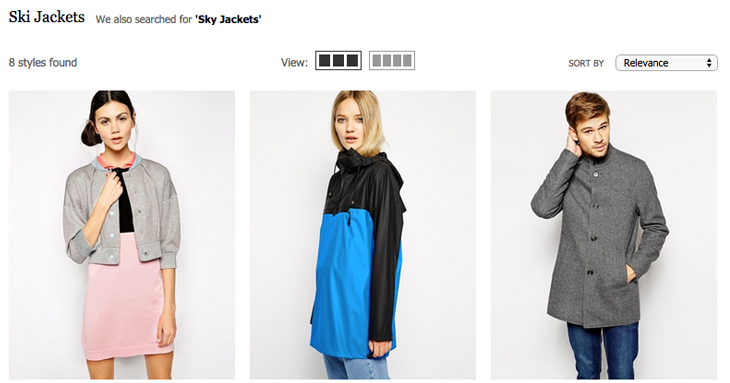
Asos
Online retailer advertised discounts on “everything” when exclusions applied.
When a Google ad offers something the advertiser can't deliver.

The closest thing to a ski jacket on the online fashion store ASOS.com is a designer raincoat that even on the more mild slopes probably wouldn’t stave off the cold for long. So why then is there a Google ad saying, in part, “Ski Jackets at ASOS – Shop The Latest Jackets”
That’s exactly what Twitter user Chris Toogood was musing on this morning after googling “ski jackets” and seeing the ad pop up. Frustrated, he tweeted at ASOS:
Hi @ASOS change your Google adwords – you don’t sell Ski wear so very misleading! #falseadvertising@ASOS_HeretoHelppic.twitter.com/G0EWE5Xif6
— Chris Toogood (@chris2good) February 20, 2015
Companies that use Google AdWords select keywords that relate to the product or service they offer. (Staples, for instance, might choose, well, staples.) When there’s a match with a term someone has googled, the company’s ad, which companies can write themselves, will appear at the top or side of the page along with other search results.
TINA.org reached out to ASOS for comment but has yet to hear back. We also contacted Google to inquire about whose responsibility it is to ensure that information in its ads are accurate. The company hasn’t immediately responded.
In the spirit of full disclosure, though, we wanted to share how TINA.org presents its Google ads via AdWords.
Click here for more of our coverage on Google ads.
Our Ad Alerts are not just about false and deceptive marketing issues, but may also be about ads that, although not necessarily deceptive, should be viewed with caution. Ad Alerts can also be about single issues and may not include a comprehensive list of all marketing issues relating to the brand discussed.
Online retailer advertised discounts on “everything” when exclusions applied.
When the photos on the website don’t match the reality.
E-commerce site changes pricing tactics in response to a TINA.org inquiry into back-to-school deals.

